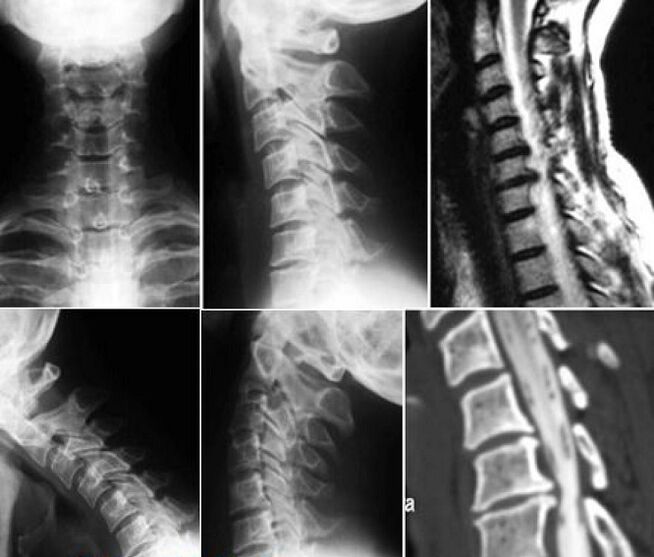Due to unhealthy lifestyles, cervical osteochondrosis is a typical disease of modern people. The nutrient deficiency of brain tissue caused by them can cause many complications, including fatal complications.
It is important to determine the pathological development in time. In the early stages, the treatment of cervical osteochondrosis was quite successful.
Signs and symptoms of the disease
The cervical spine consists of seven vertebrae. Each of them has its own function, but they are all used to support the movement of the head and neck.
The vertebrae are separated by special intervertebral discs, and their connective tissue is destroyed in osteochondrosis. This can cause changes in the position of the vertebrae, loss of flexibility of the spine, and compression of blood vessels and nerves. Due to the latter pathology, the blood supply to the brain is interrupted.
The symptoms of the disease are related to the pressure on nerve endings and blood vessels. The main features are:
- Pain in the back of the head and other parts of the head, dizziness.
- Cracks and "goose bumps" appear in the neck when moving the head.
- The painful sensation when raising the arm.
- Numbness in the arms and neck, as well as numbness in the back muscles, continued tension.
- Coordination issues.
- Nightmare, insomnia.
- Nausea, tinnitus, and vomiting.
- Mood swings.

Prolonged contact with nerves and blood vessels may cause memory loss, inattention, and speech problems.
The disease is divided into three stages, each stage has characteristic symptoms:
- initial. . . She was accompanied by the first "wake-up call" of the disease-dizziness, tinnitus, persistent fatigue, cervical pain and numbness, irritability, sleep problems.
- Sub-compensation. . . This disease inhibits the function of the central nervous system. Intelligence declines, language problems occur, and the patient's mood fluctuates. Impaired motor coordination, nausea, and vomiting.
- Decompensation. . . The pathological changes become irreversible and fatal. Most symptoms are persistent.
The sooner you find signs of illness and seek medical help, the easier and more effective the treatment will be.
Cause
Compared with similar bones in other vertebral bodies, the cervical spine is smaller and more fragile in size and structure. In addition, they are the most liquid. All of these lead to increased cervical spine pressure and intervertebral disc disease. Under the influence of changes caused by osteochondrosis, small blood vessels and nerve roots are squeezed.
Lack of exercise during sedentary work always leads to metabolic failure and an increase in lymph and blood salt. They accumulate in the cervical area. Unhealthy diet and overweight can stimulate metabolic problems, and the lack of valuable vitamins and minerals can exacerbate the deterioration of connective tissue.
The main reasons for the development of the pathological process include:
- Lack of motivation.
- Stay in the same position for a long time (in front of the computer, driving).
- Salt deposits.
- Improper diet leads to metabolic disorders.
- Lack of valuable vitamins and minerals.
- Overweight.
- Injuries and chronic diseases of the musculoskeletal system.
- Periodic hypothermia.
- Hormonal disorders.
Most risk factors can be eliminated by changing lifestyle and balancing metabolic processes in the body.
What are the risks of cerebral circulation problems?
One third of the nutrients enter the brain through the vertebral artery. If they start to narrow and the small blood vessels are squeezed due to osteochondrosis, the brain tissue will lack oxygen, as well as precious trace elements and vitamins.
Why brain hunger is dangerous:
- Heart and blood vessel dysfunction.
- Diseases of the musculoskeletal system (especially the shoulder body).
- Increased intracranial pressure.
- A slight stroke, followed by severe cerebral hemorrhage.
Neglected conditions can cause encephalopathy, a dangerous disease that causes malnutrition of brain tissue.
If you do not pay attention to the first signs of osteochondrosis and vascular dysfunction, all of these pathological conditions can occur. If the disease is diagnosed at an early stage, dangerous consequences can be avoided.
Vision and hardware diagnostics
In order to accurately find out the cause and stage of the disease, conduct a comprehensive inspection:
- Visual inspection and cervical spine palpation.
- Check the coordination of posture and movement.
- Evaluation of neck flexibility.
An experienced doctor can make a preliminary diagnosis by observing the way you walk and move your head.
Hardware research on problematic organs is also mandatory. These include:
- Radiography.
- Doppler ultrasound.
- Rheoencephalography and cerebral angiography.
- Computed tomography or MRI.
- Electrocardiogram.

The results will help identify damaged intervertebral discs and determine the extent of damage to blood vessels, spine and brain tissue. After diagnosis, start treatment immediately.
Drug therapy and non-drug therapy
If the course of the disease is accompanied by severe pain and swelling, it should be removed first. To do this, use analgesics or anesthetics to massage the neck area.
Sometimes, doctors will recommend an applicator that not only relieves pain but also relieves cramps. In some cases, pepper patches can help relieve pain. Eliminate puffiness with the help of diuretics.

The further treatment of the disease can be divided into two aspects: treatment of osteochondrosis, restoration of the spine, improvement of blood circulation in brain tissue and neuronal metabolism.
It takes time to get rid of osteochondrosis. In order to restore the health of the spine, medication and non-drug therapies are used.
The latter include:
- Remedial gymnastics.
- The help of the masseur.
- Proper nutrition.
- acupuncture.
- physiotherapy.
The best physical therapy techniques include electrophoresis and magnetic therapy. The first procedure helps relieve muscle spasms, and the second procedure-dilates blood vessels and improves metabolism between cells.
For osteochondrosis, bacon, fried food, fast food, and carbonated drinks are not recommended. Chicken and rabbit meat, boiled fish, vegetables and fruits, and herbs are considered healthy products.
In addition to anti-inflammatory drugs and analgesics, chondroprotectants are also used to restore the spine-drugs that renew the cartilage tissue of the intervertebral disc. If abnormal muscle tension is observed, muscle relaxants can be used.
In order to improve the blood flow to the brain and neuronal metabolism, doctors also prescribe some drugs. These include:
- Vasodilators and blood thinners.
- Nootropics that promote the metabolism of brain tissue. They restore concentration and memory.
- Histaminergic drugs. Stimulate specific receptors in the inner ear to help relieve vestibular dysfunction and improve motor coordination.
- Antioxidants increase the resistance to the destruction of brain cell membranes and prevent destructive oxidation reactions.

In addition, doctors recommend the use of vitamin and mineral complexes to restore the body weakened by the disease.
Only a specialist can prescribe drugs and medical procedures. Self-medication is unacceptable and fatal.
Prevention: How to prevent disease
The reason for the violation is precisely the unhealthy habits. To avoid unpleasant consequences, you must:
- Normalize weight.
- Forget about bad habits.
- Avoid hard work and strength exercise after an injury or bruise.
- Don't get too cold.
- Don't succumb to pressure.
- Balance your diet.
- Distribute the load correctly.
- Visit the swimming pool and massage room.
- Participate in sports that are not harmful to your health.
Few people can change their lives in the right direction within a day; the transformation should be done gradually.
Medical assistance is needed at the first signs of cervical osteochondrosis. Taking measures in time will avoid serious consequences.


























